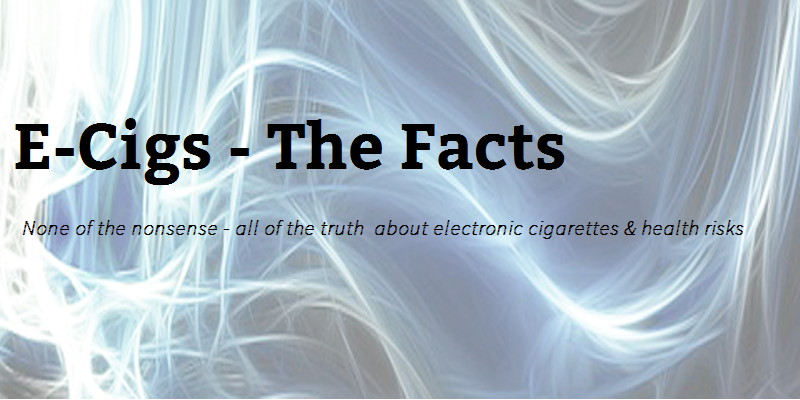E-Cigarette Health Risks
Health Risks or scare stories?
 Whether you’ve read newspapers or magazines, watched TV or just talked with friends, I’m sure you will have heard some of the scare stories; Formaldehyde, gateways to smoking, cancer causing, as bad as ordinary cigarettes, luring our children into tobacco use and so on.
Whether you’ve read newspapers or magazines, watched TV or just talked with friends, I’m sure you will have heard some of the scare stories; Formaldehyde, gateways to smoking, cancer causing, as bad as ordinary cigarettes, luring our children into tobacco use and so on.
I was fortunate when I started using e-cigs – the media hadn’t really picked up on the topic & no tobacco company had any involvement.
A bit of history
At that time, most of the medical establishment, Action on Smoking & Health (ASH), Cancer Research & Stop Smoking Services were strongly opposed to e-cigs. My own dentist thought that they would be just as bad for oral health as smoking. But, at least there were none of the horror stories like those that have been in the media in the last few years.
At first I was afraid… I was petrified
I was interested in finding out the substance of the opposition and very quickly learnt that it often boiled down to feelings rather than facts; ‘It looks like smoking’, ‘It can’t be good breathing stuff in’, ‘Nicotine is bad and highly addictive’, ‘You’re just swapping one addiction for another’, ‘It will encourage others (Usually children) to smoke’, ‘I don’t want to be breathing in your exhaled chemicals’ were just a few of the things some (often highly respected) people said to me back then.
My research background finally came in useful
 Whilst their words were still ringing in my ears, I set out to find the facts. I spoke to many medical doctors and academics that I knew – & pestered many more I’d never met who had started to look at the science. What still frightens me is that those who really knew nothing at all about the subject were prepared to offer strong views – and often those with the strongest negative views actually knew the least! It became very clear to me that there was a lot going on here unrelated to the evidence. Whilst my background in psychology helped me to understand some of the issues, it was frustrating.
Whilst their words were still ringing in my ears, I set out to find the facts. I spoke to many medical doctors and academics that I knew – & pestered many more I’d never met who had started to look at the science. What still frightens me is that those who really knew nothing at all about the subject were prepared to offer strong views – and often those with the strongest negative views actually knew the least! It became very clear to me that there was a lot going on here unrelated to the evidence. Whilst my background in psychology helped me to understand some of the issues, it was frustrating.
I read every published paper on e-cigs and nicotine and joined many forums. I seemed to have found a new hobby – well at least it kept me off the streets
Towards an answer
Lots of things emerged during my fact finding mission. The first was that nicotine might not be the highly addictive and dangerous drug that was portrayed in the media. It turned out that the view of nicotine held by most was actually based on a piece of research carried out in the late 1800’s, which would never get through an ethics committee today & whose results, though quoted widely, were dubious in the extreme. It’s not uncommon in research for this sort of thing to happen – a later researcher cites the original research but doesn’t provide much detail about it. Then, along comes another researcher who cites the second piece of research without looking at the original work. Then someone cites the third piece of research & so on. Eventually, the original work is forgotten but its findings are accepted as ‘gospel’. It shouldn’t happen & researchers are trained to go back to the source material …but human nature being what it is…
Follow the Money
 Another thing I discovered, was that were huge financial motives for ensuring that e-cigs did not become more popular. Some of these are obvious and some not so obvious. Obviously the tobacco companies didn’t want anything damaging their profits and the pharmaceutical companies didn’t want anything competing with their patches, pills and inhalators. Also, the pharmaceuticals make vast amounts of money for treating smoking related illness and if people stop smoking, their revenue streams dry-up.
Another thing I discovered, was that were huge financial motives for ensuring that e-cigs did not become more popular. Some of these are obvious and some not so obvious. Obviously the tobacco companies didn’t want anything damaging their profits and the pharmaceutical companies didn’t want anything competing with their patches, pills and inhalators. Also, the pharmaceuticals make vast amounts of money for treating smoking related illness and if people stop smoking, their revenue streams dry-up.
Not quite so obvious were the government motives.
In the UK, government coffers are filled with £12.3 billion per year (2012/13 figure) from tobacco excise & VAT. In the USA, the ‘Master Settlement Agreement’, which is linked to the number of cigarettes sold, yields over $206 billion over a 25 year period. Tobacco producing countries are also very keen to maintain their incomes and anything that reduces sales is likely to be seen in a negative light.
Whilst this is all very interesting, it doesn’t answer the question about health risks. It is important though, to put this whole area into context: It’s not just about health.
 Some Myths about E-cigs
Some Myths about E-cigs
In 1976 Professor Michael Russell wrote that: “People smoke for nicotine but they die from the tar”. E-cigs deliver nicotine without the dangerous chemicals in tobacco smoke and they provide the important hand to mouth cues, as well as producing vapour that resembles smoke.
“So what about this formaldehyde claim?”
Well formaldehyde is present in normal exhaled breath in non-smokers. The research that led to these claims pushed the e-cigs well beyond the way that they’d be used normally – in fact, no-one could tolerate the output of of an e-cig used at the levels specified in this research. So, yes e-cigs can produce formaldehyde but not in the way they are used in real-life. That study created an avalanche of bad press but the responses to it from scientists were not given any prominence. For example, see here and also this. There were also calls for the original study paper to be removed from the journal.
“Don’t they contain antifreeze?”
 This is another of the scare stories that we’ve seen. Propylene Glycol is often used in e-cigs and it is also found in some antifreezes – generally those where food is involved. It was used in antifreeze because it is regarded as much safer than ethylene glycol, which is highly toxic. The FDA also allows propylene glycol to be added to a large number of processed foods, including ice cream, frozen custard, coffee flavoured drinks, salad dressings and baked goods. It’s often shown on food labels as E1520. Vaporizers used for delivery of pharmaceuticals or personal-care products often include propylene glycol among the ingredients.
This is another of the scare stories that we’ve seen. Propylene Glycol is often used in e-cigs and it is also found in some antifreezes – generally those where food is involved. It was used in antifreeze because it is regarded as much safer than ethylene glycol, which is highly toxic. The FDA also allows propylene glycol to be added to a large number of processed foods, including ice cream, frozen custard, coffee flavoured drinks, salad dressings and baked goods. It’s often shown on food labels as E1520. Vaporizers used for delivery of pharmaceuticals or personal-care products often include propylene glycol among the ingredients.
Way back in the 1940’s, detailed research was carried out on propylene glycol. Due to its low chronic oral toxicity, propylene glycol was classified by the U. S. Food and Drug Administration as “generally recognized as safe” (GRAS) .
“We don’t yet know about vaping. I mean clearly they put in flavourings, we don’t know the impact of those. Butterscotch has had to be withdrawn because people got chronic lung disease.”
 This is a quote from Dame Sally Davies on a BBC programme. Exactly why the UK’s Chief Medical Officer decided to say this is unclear. But let’s pick it apart using facts.
This is a quote from Dame Sally Davies on a BBC programme. Exactly why the UK’s Chief Medical Officer decided to say this is unclear. But let’s pick it apart using facts.
Some butterscotch e-liquid was withdrawn voluntarily when a responsible e-liquid firm (VIP) found traces of a chemical called diacetyl in their routine testing. The chemical is used in food flavourings to give a buttery taste. No-one was hospitalised and the Department of Health have no record of anyone being admitted to hospital or treated by a GP as a result. It seems that there were no cases of chronic lung disease attributed to e-liquid.
Now there is a disease, bronchiolitis obliterans, also known as ‘popcorn lung’ which was thought to be associated with diacetyl. When inhaled over long periods of time and at high levels, some workers in the food industry – popcorn producers in fact – contracted the disease and it was believed that it might have been caused by diacetyl – but the link was never proven. In fact, tobacco cigarettes have been found to contain diacetyl at significantly higher levels than those in the butterscotch liquid and there are no recorded cases of smokers contracting bronchiolitis obliterans – which you might expect if there was a risk.
In order to reach the conclusion that Dame Sally reached, you need to add together the above information and present it as one reliable piece of evidence. The truth is that there is no established connection between diacetyl & popcorn lung and there are no recorded lung disease incidents attributed to e-liquid.
In response to a freedom of information request, the Department of Health admitted that there was no evidence and argued that Dame Sally “…truncated information…”. It beggars belief to find that the DoH think it is acceptable for Dame Sally Davies, CMO, to “truncate” statements on Public Health matters so much so that they have no basis in truth.
There is no doubt that any potentially harmful chemicals should be excluded from e-liquid, as should unnecessary colouring. Consumers, however, need the truth and scaremongering like this is irresponsible at best.
This topic pops up regularly but levels found in e-cigs tend to be between 10 and 100 times lower than those found in traditional cigarettes and there are no reported cases of smokers getting popcorn lung. Furthermore, it was never proven that the 8 cases in the popcorn factory were actually caused by diacetyl.
“There have been many cases of e-cig users getting Lipoid Pneumonia”
 Well, worldwide, there have actually been two recorded cases. Lipoid pneumonia is a serious illness that can occur if you inhale oil or fatlike materials. Sadly, the Spanish media widely publicised one case and attributed it to e-cigs, causing many users to go back to tobacco.
Well, worldwide, there have actually been two recorded cases. Lipoid pneumonia is a serious illness that can occur if you inhale oil or fatlike materials. Sadly, the Spanish media widely publicised one case and attributed it to e-cigs, causing many users to go back to tobacco.
Several respected medics have written about the unlikelihood of any link between e-cigs and lipoid pneumonia. Professor Riccardo Polosa is Director of the Institute for Internal and Emergency Medicine of the University of Catania in Italy. He is also in charge of the University’s Centre for Tobacco Research (CPCT), and Honorary Professor of Medicine at Southampton University (UK). He is the author of more than 250 peer reviewed articles and books mainly covering respiratory medicine, clinical immunology, and tobacco addiction. On top of his academic work, he serves also as chief scientific advisor for Lega Italiana Anti Fumo (LIAF), the Italian Anti-Smoking League. Prof Polosa’s and his research team have lead several clinical trials on e-cigarettes.
Polosa said: “…There is no way that regular exposure to glycerin in e-vapor will cause accumulation of fatlike material in the lung, because glycerin is not a lipid, but an alcohol. In the Spanish case, radiological evidence for lipoid pneumonia was preceding electronic cigarette use, hence it was not a consequence of vaping. In both cases I could identify a more plausible cause for these patients’ lipoid pneumonia…”
“But heavy metals have been found in e-cigs”
This is true – but they are at levels way below the maximum permissible daily exposure from inhalational medications according to the US Pharmacopeia. And, whilst there could be some residual risk from them, the levels are very much lower than those found in tobacco cigarettes. In reality, there is a much greater risk from environmental pollution and radon gas than there is from vaping.
“Nicotine is a poison and it’s used in pesticides”
 This is also true. The problem with such statements is that they are used by Journalists to create emotional or sensational impact – often when the science tells a very different story. It is the dose that makes the poison and so everything is toxic at some level – oxygen and water are both toxic at high levels, for example. The nicotine used in e-cigs is the same stuff that is used in NRT medicines but both are highly diluted forms of the drug.
This is also true. The problem with such statements is that they are used by Journalists to create emotional or sensational impact – often when the science tells a very different story. It is the dose that makes the poison and so everything is toxic at some level – oxygen and water are both toxic at high levels, for example. The nicotine used in e-cigs is the same stuff that is used in NRT medicines but both are highly diluted forms of the drug.
The Austrian toxicologist Professor Bernd Mayer was the first to question the accepted wisdom of nicotine’s toxicity. He first investigated where the accepted LD50 levels (the dose expected to kill 50% of those who receive it) originated. He found that it stems originally from some dubious self-experiments performed in the mid-1800’s and had just become accepted wisdom. Worse still, his own work showed that a lethal dose probably needed to be 10 or 20 times higher than was believed. (http://link.springer.com/article/10.1007%2Fs00204-013-1127-0/fulltext.html)
But let’s give Polosa the final word:
“…to a cigarette smoker considering switching to e-cigs, but worried by potential health risks I would simply say if the health risk associated with tobacco smoking is equal to 100, vaping health risk is 4. The choice is yours.”
Originally Published by Dave Upton 2015 – Reproduced by ocdz.co.uk with kind permission





